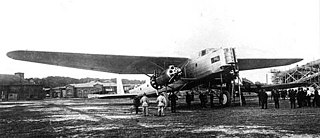Related Research Articles

The Sukhoi Su-12 was a prototype Soviet reconnaissance and artillery spotter aircraft developed during World War II.

Grigorovich M-5 was a successful Russian World War I-era two-bay unequal-span biplane flying boat with a single step hull, designed by Grigorovich. It was the first mass production flying boat built in Russia.

Grigorovich M-9 was a Russian World War I-era biplane flying boat, developed from the M-5 by Grigorovich.

Grigorovich M-15 was a successful Russian World War I-era biplane flying boat, developed from the M-9 by Grigorovich.
Grigorovich M-16 was a successful Russian World War I-era biplane flying boat of the Farman type, developed from the M-9 by Grigorovich. Somewhat larger than the M-9, the M-16 was a version especially intended for winter operations, with better aerodynamic qualities.
The Tupolev MTB-1 was a patrol flying boat built in the Soviet Union in the mid-1930s. It was a refined version of the unsuccessful Chyetverikov MDR-3. The revised design retained the MDR-3's hull, but added a newly designed, full-cantilever wing, a new tail, and a new engine installation featuring two tractor and one pusher unit. Trials began in March 1934 but the prototype was destroyed during one takeoff.

The Grigorovich I-Z was a fighter aircraft developed in the Soviet Union during the 1930s. Advances in aircraft survivability thanks to all-metal construction and self-sealing and inert gas-filled fuel tanks led to experimentation with large-caliber weapons to shoot them down. In Soviet Union, Leonid Kurchevsky developed a series of recoilless rifles in various calibers and in 1930 was decided to adapt the 76.2 mm (3 in) weapons for aircraft use.

The Grigorovich M-11 was a Russian single-seat fighter flying boat designed by Dmitry Pavlovich Grigorovich and built by Shchetinin

The Grigorovich TB-5 was an experimental heavy bomber designed and tested in the Soviet Union in the early 1930s. Designed as a competitor for the Tupolev TB-3, the TB-5 was intended to be powered by two FED 24-cylinder X engines of 746 kW (1,000 hp) each. When these were canceled, the underwing pods were revised to each house a pair of Bristol Jupiter engines in a push-pull configuration. Despite projected performance inferior to TB-3, it was hoped that TB-5 would gain an advantage by using less metal thanks to its mixed construction of fabric-covered metal frame.

Grigorovich DI-3, , was a prototype two-seat fighter developed in the Soviet Union in the 1930s. It was intended to be a long-range escort fighter developed from the DI-2 with improved range and performance comparable to single-seat fighter aircraft of the time. DI-3 was a single-bay biplane of mixed construction with a twin-rudder tailplane of variable incidence. Although initial tests demonstrated flight characteristics comparable to Polikarpov I-5, the addition of armament and operational equipment caused significant degradation in performance and DI-3 did not enter mass production. The prototype was subsequently fitted with an enclosed cockpit and used as a VIP transport.

The Moskalyev SAM-13 was a prototype twin-engined single-seat low-wing fighter built in the Soviet Union in the 1930s.
The Grigorovich MK-1 was a large trimotor floatplane, built and tested in Imperial Russia in 1916.
The Grigorovich MU-2 was a trainer flying boat built in the Soviet Union in the mid-1920s. It was designed by the Grigorovich Design Bureau after the failure of the Grigorovich MUR-1, featuring an all-metal hull. However, it was never put into production due to poor performance and sluggish take-off behavior.
The Grigorovich MUR-1,, was a trainer flying boat built in the Soviet Union in the mid-1920s.
The Grigorovich M-19 was a reconnaissance flying boat designed by Grigorovich in the late 1910s. The M-19 was a Grigorovich M-9 modified to be of the same size as the Grigorovich M-15. Assembly of the prototype was started in 1918, but the aircraft was not completed.
The Grigorovich M-23bis was a Soviet biplane flying boat built during the 1920s.
The Grigorovich ROM-2 was a long-range reconnaissance flying boat designed by the Grigorovich Design Bureau for the Soviet Navy in the late 1920s.
The Grigorovich MR-5 was a long-range reconnaissance flying boat designed by the Grigorovich Design Bureau for the Soviet Navy in the late 1920s.
The Grigorovich MRL-1 was a long-range reconnaissance flying boat designed by the Grigorovich Design Bureau for the Soviet Navy in the mid-1920s.
The Grigorovich MR-2 was a long-range reconnaissance flying boat designed by the Grigorovich Design Bureau for the Soviet Navy in the late 1920s.
References
- ↑ Shavrov, V.B. (1988). Istorii︠a︡ konstrukt︠s︡iĭ samoletov v SSSR do 1938 g. (Izd. 5-e, ispr ed.). Moscow: Mashinostroenie. p. 398. ISBN 5-217-03112-3.
- ↑ "ROM-1, D.P.Grigorovich". Russian Aviation Museum. Retrieved 2 February 2019.
- ↑ Gunston, Bill (1983). Aircraft of the Soviet Union : the encyclopaedia of Soviet aircraft since 1917. Osprey. p. 93. ISBN 085045445X.